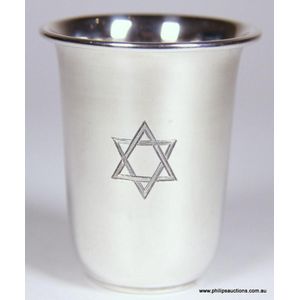Victorian Silver Tea Caddy with Elaborate Crest and Arms
A Victorian silver plain canister form tea caddy, most gilt remains to exterior and interior, plain cylinder form, recessed lid, a fine engraved elaborate crest and arms for Spencer-Bulkeley [Wynn], 3rd Baron Newborough (1803-1888) [Sable three fleurs-de-lis argent; crested: a dexter arm erect holding a fleur-de-lis; flanked by lions above the motto: Suaviter In Modo Fortiter In Re (Gentle in manner, vigorous in action)]. London 1872 by The Goldsmiths & Silversmiths Co. 520gms. Height 15 cm, diameter 9.5 cm
You must be a subscriber, and be logged in to view price and dealer details.
Subscribe Now to view actual auction price for this item
When you subscribe, you have the option of setting the currency in which to display prices to $Au, $US, $NZ or Stg.
This item has been sold, and the description, image and price are for reference purposes only.
- Victorian Period - The Victorian period of furniture and decorative arts design covers the reign of Queen Victoria from 1837 to 1901. There was not one dominant style of furniture in the Victorian period. Designers used and modified many historical styles such as Gothic, Tudor, Elizabethan, English Rococo, Neoclassical and others, although use of some styles, such as English Rococo and Gothic tended to dominate the furniture manufacture of the period.
The Victorian period was preceded by the Regency and William IV periods, and followed by the Edwardian period, named for Edward VII (1841 ? 1910) who was King of the United Kingdom and the British Dominions and Emperor of India for the brief period from 1901 until his death in 1910. - Fleur-De-Lis - The fleur-de-lis is a stylized lily or iris flower with
three petals that has been used as a decorative motif for thousands of years. It
often appears in Christian iconography symbolising the Holy Trinity and as an
emblem that reflects the purity of the Virgin Mary. In decorative art and antiques
decoration, the fleur-de-lis is often used as a symbol of elegance, refinement,
and good taste.
The fleur-de-lis has a rich history and in ancient times, it
was associated with royalty, purity, and the divine, and it was used as a
symbol of the French monarchy for many centuries.
It is a common design element in ceramics, silverware, jewellery,
furniture, and other decorative objects, and it can be found in many different
styles and forms.
This item has been included into following indexes:
Visually similar items

Stg silver Queen Victoria 60th diamond jubilee, serviette ring, hallmarked London 1897
Sold by
in
for
You can display prices in $Au, $US, $NZ or Stg.

Sold by
in
for
You can display prices in $Au, $US, $NZ or Stg.

A French silver-plated wine bucket marked Moet and Chandon. 21 cm high
Sold by
in
for
You can display prices in $Au, $US, $NZ or Stg.

A sterling silver kiddush cup, the tapering beaker with a rolled rim, engraved with the Star of David and script in Hebrew; marked 925 to base with maker's mark Ppm in triangle, with additional mark of GB326. Silver weight 81gr. Height 7.5 cm
Sold by
in
for
You can display prices in $Au, $US, $NZ or Stg.
